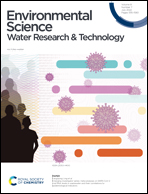The development of a rapid monitoring method for radiocesium in seawater in the Fukushima region
Abstract
Very recently, we reported the preparation of several types of Prussian blue analogue (PBA) nanoparticle (NP) slurries with varying compositions (KCuHCF-NPs, AyCu[Fe(CN)6]1−x·zH2O) and different NP sizes via systematically tuning the synthetic conditions using a Y-type micro-mixer at a high flow rate of 200 mL min−1 for the recovery of cesium (Cs) from seawater in the presence of competing ions [Environ. Sci.: Water Res. Technol., 2019, 5, 1328–1338]. Here, we report a new monitoring method for the rapid assessment of low levels of radioactive Cs (137-Cs) and its effective concentration and quantification in Fukushima seawater, directly using KCuHCF-0.26 NPs (K1.02Cu[Fe(CN)6]0.74·2.63H2O) slurry ink. Laboratory test measurements of stable 133-Cs using KCuHCF-0.26 in simulated seawater showed Cs recovery exceeding 99.5% within 30 min. A pilot large-scale experiment conducted in conditioned seawater (100 L tank) with 137-Cs and 133-Cs (500 μg L−1) using KCuHCF-0.26 slurry at Tokyo Power Technology Ltd (TPT), Japan, agreed with the laboratory results, exhibiting high Cs recovery efficiencies over a wide pH range of 5–9. A high adsorbent to solution ratio of 10 000 mL g−1 was applied to selectively adsorb Cs in the presence of competing coexisting ions in seawater, meaning most 137-Cs in 1000 L of solution could be concentrated into only 0.1 kg of KCuHCF-NPs; thus, much lower levels of radiation in seawater could be recovered. The proposed method shortened the preconcentration and pre-treatment times of 137-Cs to ca. 30 min in a 100 L conditioned seawater tank and a germanium detector (Ge-detector) container packed with flocculated KCuHCF-0.26 flocs. This study examines the effectiveness of this method involving mixing KCuHCF-0.26 slurry ink, with strong Cs-adsorption abilities, with seawater containing 137-Cs, including the addition of 133-Cs as an elution suppression measure.

- This article is part of the themed collection: Environmental Science: Water Research & Technology Recent HOT Articles


 Please wait while we load your content...
Please wait while we load your content...